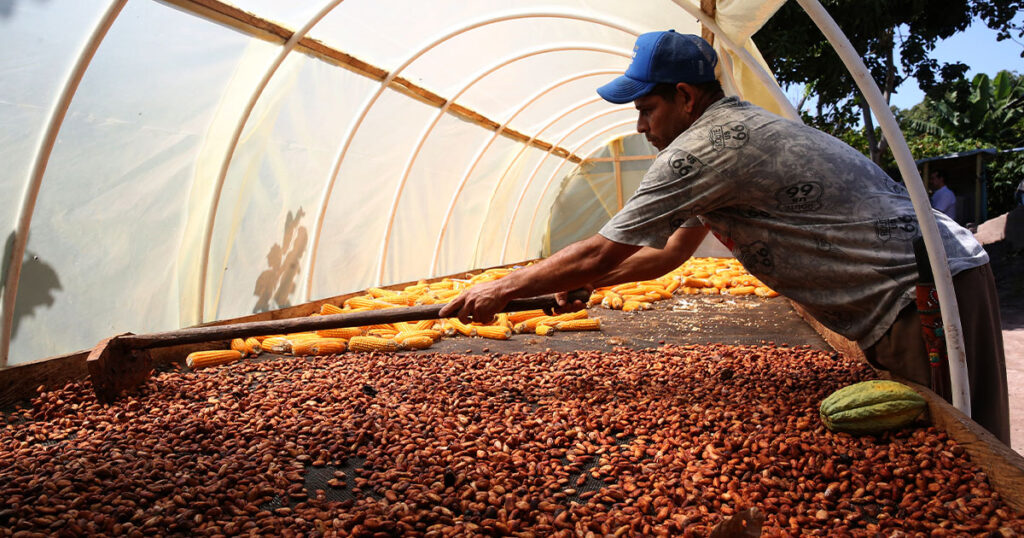
Wild Chocolate: Across the Americas in Search of Cacao’s Soul by Rowan Jacobsen; Bloomsbury, 288 pp., $28.99
Your meal at Hank’s Oyster Bar, a small seafood chain in the Washington, D.C. area, always ends in something sweet, even if you don’t order dessert: a petite glass bowl loaded with chunks of dark chocolate, a gift from the house. As with most gifts, you don’t ask questions. You just savor the morsels, as the chocolate crumbles and slowly melts, releasing buttery, subtly fruity flavors across your tongue.
This brief moment of bliss, however, is not free of guilt, as I learned recently after asking Jamie Leeds, the chef and owner of Hank’s, about the source of her treats. These nuggets of dark chocolate are made by Callebaut, a large Belgian company that blends beans from three countries, including Côte d’Ivoire and Ghana, where farmers have mercilessly altered the landscape to become the epicenter of cacao production. As journalist and author Rowan Jacobsen writes in his latest masterwork, Wild Chocolate, “The land where these farms were being cleared was rainforest, much of it in ostensible preserves, but there was nobody to mind the store. Today, Ghana and Ivory Coast account for two-thirds of world production, a huge amount of it from supposed preserves, and their forests are essentially gone.”
The sacrifices that Côte d’Ivoire and Ghana have made to become world leaders in cacao production are many: not just rainforests, but genetic diversity (and the loss of flavor associated with their preferred hybrids) and even basic human decency. Millions of Africans collect about a dollar a day, Jacobsen informs us, to grow the beans that are transformed into our chocolate pleasures, which assuredly cost more than farmers earn for their daily labor. What’s more, according to the U.S. government, more than 1.5 million children still work in the cacao industry in Ghana and Côte d’Ivoire, despite repeated pledges from Big Chocolate to end the practice.
Jacobsen doesn’t let you, me, or the rest of the Western world’s chocoholics off the hook for this sorry state of affairs. “The real villain was the market,” he writes, “and the fact that rich nations were happy to let these struggling young nations liquidate their natural and human capital at the lowest possible price.” If Wild Chocolate sounds like a plodding indictment of Big Chocolate and the people who prop it up, rest assured that Jacobsen also has a better, more hopeful, story to tell. But to tell it, he has to provide some history to explain how a beloved indulgence—one hopelessly intertwined with love, joy, and sex—masks a multibillion-dollar industry rooted in human exploitation and environmental destruction.
The backdrop helps you appreciate the overlapping stories that Jacobsen lays out, each focused on an outlier who has struggled to reclaim parts of a chocolate industry lost to a commodity system that values price and plausible deniability above all else. Jacobsen introduces us to fearless souls who hack their way through jungles in search of wild cacao trees that established chocolate professionals thought had been extirpated. They’re often enterprising souls, too: do-gooders who want to cut out the many middlemen between the farmer and the consumer, bringing more transparency to chocolate lovers and more money to cacao farmers.
Jacobsen takes us on a trip to Bolivia to meet Volker Lehmann, a German agroforestry expert who harvests wild cacao in the Beni lowlands of the Amazon, now understood to be ground zero for chocolate, not Mesoamerica as previously thought. Lehmann purchased a 13,000-acre parcel packed with cacao trees—land later discovered to be part of the ancient Casarabe civilization—and somewhat reluctantly entered a specialty chocolate trade that, he would soon learn, could be as cutthroat as that of the big boys.
Jacobsen meets up with other pioneers in the bean-to-bar movement, the chocolate equivalent of farm-to-table. We are introduced to Emily Stone, an American who uprooted her comfortable life in Boston to move to Belize and build a thriving specialty export business good for chocolatiers, consumers, and farmers alike. We spend time with Luisa Abram, who quit medical school to devote her life to the wild cacao of the Brazilian Amazon, harvesting the pods and transforming their seeds into exquisite chocolates. We learn about the Heirloom Cacao Preservation Fund, a nonprofit organization that identifies and preserves endangered cacao varieties.
Along the way, Jacobsen and his sources have encounters with wild animals, bloodthirsty insects, and mysterious locals, sometimes armed, who aren’t always thrilled at the idea of losing the cacao trade to white interlopers. These adventures, on the river and in the jungle, seem to have had an effect on Jacobsen: he repeatedly lapses into the first-person plural, as if he had moved from neutral observer to active participant in the process of reporting his book. He also tells stories mostly from the point of view of the entrepreneurs, not the farmers, who, I suspect, might have a different tale to tell on the bean-to-bar movement.
The greatest appeal of Wild Chocolate comes in its slow, page-by-page seduction. After absorbing Jacobsen’s prose about bars produced from wild cacao—he describes a Juruá chocolate from Luisa Abram as having a “perfume, like jasmine blossom, but also tropical fruit notes, and really beautiful herbals”—you can’t help but want to try some yourself. So one afternoon I spent more than $50 on a one-pound bag of Felchlin dark couverture chocolate, made from Bolivian cacao, which tasted of caramel, nuts, and stone fruit.
This, I thought, is the price not just of superb chocolate, but of supporting a nascent industry that cares as much about people and the environment as it does profits.

